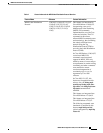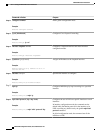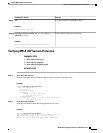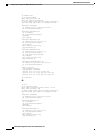
MPLS LDP Session Protection
The MPLS LDP Session Protection feature provides faster label distribution protocol convergence when a
link recovers following an outage. MPLS LDP Session Protection protects a label distribution protocol
(LDP) session between directly connected neighbors or an LDP session established for a traffic
engineering (TE) tunnel.
• Finding Feature Information, page 31
• Restrictions for MPLS LDP Session Protection, page 31
• Information About MPLS LDP Session Protection, page 31
• How to Configure MPLS LDP Session Protection, page 33
• Configuration Examples for MPLS LDP Session Protection, page 36
• Additional References, page 39
• Command Reference, page 40
Finding Feature Information
Your software release may not support all the features documented in this module. For the latest feature
information and caveats, see the release notes for your platform and software release. To find information
about the features documented in this module, and to see a list of the releases in which each feature is
supported, see the Feature Information Table at the end of this document.
Use Cisco Feature Navigator to find information about platform support and Cisco software image support.
To access Cisco Feature Navigator, go to www.cisco.com/go/cfn. An account on Cisco.com is not required.
Restrictions for MPLS LDP Session Protection
This feature is not supported under the following circumstances:
• With TDP sessions
• With extended access lists
• With LC-ATM routers
Information About MPLS LDP Session Protection
MPLS LDP Session Protection maintains LDP bindings when a link fails. MPLS LDP sessions are
protected through the use of LDP Hello messages. When you enable MPLS LDP, the label switched routers
(LSRs) send messages to find other LSRs with which they can create LDP sessions.
MPLS LDP Configuration Guide, Cisco IOS Release 12.4
31


















